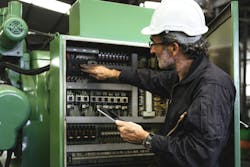Key highlights
- The driving force behind major control system upgrades is component obsolescence, particularly the main processor, which necessitates decisions between direct processor replacement or a complete control panel overhaul based on the condition of the existing panel and wiring.
- Upgrading systems to a modern controller is a common and rewarding engineering challenge, often involving replacing legacy network protocols with a modern one to maintain communication with existing machine I/O.
For nearly 10 years, this space has permitted me to share the experiences of design from the perspective of a controls engineer working in the field of packaging machinery for a producer of consumer goods. The vantage point of being, essentially, an original equipment manufacturer (OEM) inside an end user has been not only unique, but hugely rewarding.
As an end user, we get firsthand exposure to what current vendors in the industry are using to produce new machinery. Also, as an end user, we had the opportunity to examine ways to give our legacy equipment a new lease on life in the form of upgrades.
Recently, I had the opportunity to make a career change that gives me a fresh perspective on control design and an opportunity to work completely remotely. I have shifted from consumer goods packaging into material handling systems. This is a bit of a trip down memory lane for me, as I spent a significant part of my earlier career in conveying and sorting systems, and this brings me full circle to my origins.
While the approach is similar, the view from my desk today is greatly expanded with the proliferation of automated warehouses and distribution centers in today’s online shopping environment. I am excited to jump into this new experience and learn more about the technology that goes into control system development for this important segment of the world of commerce.
The first thing I encountered in my new position is that the past 15 years I spent guiding the upgrade of controls systems has followed me from the in-plant office to the home office. In my previous job we executed many upgrades to “smart relay” controllers to make them all the same brand and model, but it was the bigger systems that provided the greater challenge, and the end results were very rewarding.
Upgrades can take various paths, depending on the age of the equipment and how well it was taken care of. Most of you have likely just had some vivid memories come to life, both good and bad.
We’ve all probably opened a control panel only to see missing wireway covers and wires just hanging down or strewn across the expanse of the enclosure. Often, there is a real risk of shock or short from power and control wires intermixed and wound around each other. Perhaps the insulation on the conductors has aged to the point where they have lost the physical characteristics that make them insulators. Others may appear to be intact until they are touched or moved around, and then chunks of insulation drop off the wires, making them even more unsafe. The devices on the panel may have suffered from age, as well. Components perhaps not on the DIN rail any more are so degraded with age that they barely resemble the devices they once were.
Other times, we might have opened an enclosure only to discover, to our delight, that great care has been exercised, and the results look like they just came out of the panel shop that built it. All the wires are tucked into the proper places and routing. Components appear to be fresh and mounted in their original locations.
When deciding whether to perform an upgrade, the above examples give us some of the vital information needed to make an informed decision, but they are only part of the decision process. Ultimately, the decision to go down the path of an upgrade is based on the ability of the machine or process to do the job it was designed to do and what risk do we encounter if that function is lost due to failure of the controls.
As it turns out, the real driving force behind the decision to upgrade is component obsolescence. Minor components like relays and contactors can usually be replaced with modern versions that perform the same function, usually in a small form factor that improves panel space. However, it is the major components that force bigger decisions. The biggest of them all, of course, is the processor that drives all those components. The processor is the heartbeat of the control system. Everything that happens, whether locally, in the main panel, or remotely, in sub-panels or on the machine itself, emanates from or passes through the main processor chassis.
Get your subscription to Control Design’s daily newsletter.
For most vintage systems, the main chassis also provides a gateway for any networked devices. It is also not uncommon to find more than one network protocol present in these older designs. For example, with my previous employment, we primarily worked with Allen-Bradley SLC 500-based systems. Those systems used a lot of Remote IO, Data Highway (DH), Data Highway Plus (DH+), Data Highway 485 (DH-485) and DeviceNet protocols, many of which were on the same machine or process. A few systems involved EtherNet/IP as that was still an evolving technology at the time this equipment was purchased, from 1980 to 2000.
In my new position, I have run into an old friend—the 1771-based PLC-5 again from Rockwell Automation Allen-Bradley. I cut my teeth on the PLC-5 and its predecessor, the PLC-2 in automotive and cereal plants very early in my career. This processor isn’t an old piece of equipment sitting in a boneyard—I did run into one in my previous job on an old cartoner that we purchased at auction—but in daily operation in a distribution warehouse.
Now one might immediately think how could the user still have something that old in operation. Well, for me, I look upon such encounters with reverence as that system was likely installed in the late 1980s or early 1990s and has been faithfully serving ever since. This speaks volumes to the robust design and quality of components that went into this 40-year-old programmable controller and associated I/O components.
The above two examples, the modular SLC-500 and the chassis-based PLC-5, can be found with many other hardware brands as the good ones seem to last forever. At some point, however, the specter of obsolescence raises its ugly head, and we are faced with a decision on how to move forward.
For me, the SLC-500 upgrade was split into two paths. If the panel was clean and the wires and insulation were in good condition, we would plot a path to directly replace the SLC-500 with the newer 1769-based, now 5069-based, CompactLogix product line. If the original control panel had lots of obsolete components and the wiring was a mess, then a completely new control panel with the new technology was the way to go.
The SLC and the CompactLogix share the same approximate footprint, so a processor swap out is straightforward and involves very little in the way of work, other than pulling the connectors off the original processor and modules and then manually moving the wires from old assembly to the new one.
In this situation, the older processor likely used Remote IO for additional I/O chassis, and this can be directly replaced with EtherNet/IP communication modules in the new system. The I/O on the machine doesn’t care how it gets to talk to the PLC, just as long as it can.
This process of moving wires from old to new can be expedited if the originals were wired to terminals. The panel technician could use coded cable to pre-wire the new I/O modules at the comfort of a work bench and then simply connect the other end to the terminal blocks in the control cabinet. My technician liked to use an 18-conductor machine cable for this purpose so that the numbers simply went in order from 1 to 16 for the I/O points, and the remaining wires provided power and common to the module, if needed.
About the Author
Rick Rice
Contributing Editor
Rick Rice is a controls engineer at Trew Automation, a material handling manufacturer based in West Chester, Ohio. With over 38 years’ experience in the field of automation, Rice has designed and programmed everything from automotive assembly, robots, palletizing and depalletizing equipment, conveyors and forming machines for the plastics industry but most of his career has focused on OEM in the packaging machinery industry with a focus on R&D for custom applications.

Leaders relevant to this article:

